Module Objectives
This module covers various techniques, tools and tackles used for Session Hijacking. On completion of this module you will be familiar with the following areas:
-
Spoofing Vs Hijacking
-
Types of session hijacking
-
TCP/IP concepts
-
Performing Sequence prediction
-
ACK Storms
-
Session Hijacking Tools
| |
-
Understanding the flow of message packets over the Internet by dissecting the TCP stack.
-
Understanding the security issues involved in the use of IPv4 standard
-
Familiarizing with the basic attacks possible due to the IPv4 standard.
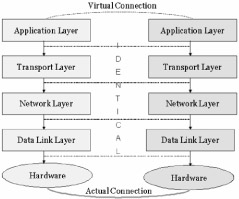
| |
| Concept | At its simplest level, TCP hijacking relies on the violation of trust relationships between two interacting hosts . Before we go into the details of session hijacking, let us take a look at the TCP stack and the IPv4 protocol, to understand why this attack is possible. |
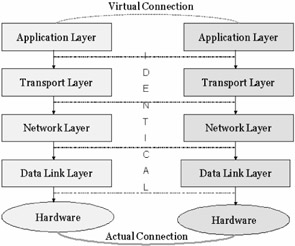
Consider the everyday scenario when you access the Internet with your browser - say IE. IE works at the application layer and accepts the initial datagram to be sent across the Internet. The transport protocol comes into action in the next layer - aptly called the transport layer - and the appropriate protocol header is added to the datagram. Here it is TCP header, as it is the TCP protocol that is being used. This ensures the reliability of data transported over inherently unreliable communication platforms, and also controls many of the aspects in the management and initiation of communication between the two hosts. In the network layer, routers offer the functionality for the datagram to hop from source to the destination, one hop at a time. This also sees the IP header being added to the datagram. The final layer that communicated with the physical hardware is the data link layer. This layer is responsible for the delivery of signals from the source to the destination over a physical communication platform, which in this case is the Ethernet. This layer also sees the frame header being added to the datagram.
Now, the headers are peeled back on reaching the destination to reveal the original datagram. Having understood the TCP stack, let us look at IPv4. The original IPv4 standard needed to address three basic security issues - authentication, integrity and privacy. Authentication was an issue because an attacker could easily spoof an IP address and exploit a session. Spoofing was not restricted to IP address alone, but also extended to MAC addresses in ARP spoofing. An attacker sniffing on a network could sniff packets and carry out simple attacks such as change, delete, reroute , add, forge or divert data. Perhaps the most popular among these attacks is the Man-In-the-Middle attack. An attacker can grab unencrypted traffic from a victim's network-based TCP application, further tampering with the authenticity and integrity of the data before forwarding it on to the unsuspecting target.
| |
A spoofing attack is different from a hijack in that an attacker is not actively taking another user offline to perform the attack. he pretends to be another user or machine to gain access.
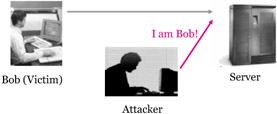
| |
| Note | The early record of a session hijacking is perhaps the Morris Worm episode that affected nearly 6000 computers on the ARPANET in 1988. This was ARPANET's first automated network security incident. Robert T. Morris wrote a program that would connect to another computer, find and use one of several vulnerabilities to copy itself to that second computer, and begin to run the copy of itself at the new location. Both the original code and the copy would then repeat these actions in an infinite loop to other computers on the ARPANET. |
Though this has found reference time and again in the context of worms and denial of service, the basic working of the Morris worm was based on the discovery that the security of a TCP/IP connection rested in the sequence numbers and that it was possible to predict them.
| Concept | Blind IP spoofing involves predicting the sequence numbers that the victimized host will send in order to create a connection which appears to originate from the host. Before exploring blind spoofing further, let us take a look at sequence number prediction. |
TCP sequence numbers are used to provide flow control and data integrity for TCP sessions. Every byte in a TCP session has a unique sequence number. Moreover, every TCP segment provides the sequence number of the initial byte (ISN), as part of the segment header. The initial sequence number does not start at zero for each session. Instead, the participants specify initial sequence numbers as part of the handshake process-a different ISN for each direction-and begin numbering the bytes sequentially from there.
Blind IP spoofing relies on the attacker's ability to predict sequence numbers as he is unable to sniff the communication between the two hosts by virtue of not being on the same network segment. He cannot spoof a trusted host on a different network and see the reply packets because the packets are not routed back to him. He cannot resort to ARP cache poisoning as well because routers do not route ARP broadcasts across the Internet. As he is not able to see the replies he is forced to anticipate the responses from the victim and prevent the host from sending a RST to the victim. The attacker then injects himself into the communication by predicting what sequence number the remote host is expecting from the victim. This is used extensively to exploit the trust relationships between users and remote machines, these services include NFS, telnet, IRC, etc.
IP spoofing is relatively easy to accomplish. The only pre-requisite on part of the attacker is to have root access on a machine in order to create raw packets. In order to establish a spoofed connection the attacker must know what sequence numbers are being used. Therefore, IP spoofing forces the attacker to have to predict the next sequence number.
The attacker can use "blind" hijacking, to send a command, but can never see the response. However, a common command would be to set a password allowing access from somewhere else on the net. The attack became famous when Kevin Mitnick used it to hack into Tsutomu Shimomura's computer network. The attack exploited the trust that Shimomura's machines had with the other network. By SYN flooding the trusted host, Mitnick was able to establish a short connection which was then used to gain access through traditional methods .
| |
With Hijacking an attacker is taking over an existing session, which means he is relying on the legitimate user to make a connection and authenticate. Then take over the session.
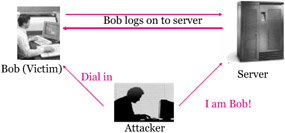
| |
With IP Spoofing there is no need to guess the sequence number since there is no session currently open with that IP address. The traffic would get back to the attacker only by using source routing. This is where the attacker tells the network how to route the output and input from a session, and he simply sniffs it from the network as it passes by him. Source routing is an IP option used today mainly by network managers to check connectivity. Normally, when an IP packet leaves a system, its path is controlled by the routers and their current configuration. Source routing provides a means to override the control of the routers.
| Concept | When an attacker uses captured, reverse engineered or brute forced authentication tokens to take over the control of a legitimate user's session while he is in session, the session is said to be hijacked. Due to this attack, the legitimate user may loose access or be deprived of the normal functionality of the session to the attacker, who now acts with the user's privileges. |
Most authentications occur at the beginning of a TCP session, this makes it possible for the attacker to gain access to a target machine. A popular method attackers adopt is to use source-routed IP packets. This allows an attacker to become a part of the target - host conversation by deceiving the IP packets to pass through his system. The attacker can also carry out the classic man-in-the-middle attack using a sniffing program to monitor the conversation.
In TCP session hijacking, a familiar aspect of the attacks is the carrying out of a denial-of-service (DoS) attack against the target / host to prevent it from responding by either forcing the machine to crash, or against the network connection to result in a heavy packet loss (e.g. SYN flood).
| Note | Session hijacking is even more difficult than IP address spoofing. In session hijacking, John would seek to insert himself into a session that Jane already had set up with \\Mail. John would wait until Jane established a session, then knock her off the air by some means and pick up the session as though he was her. As before, John would send a scripted set of packets to \\Mail but would not be able to see the responses. To do this, he would need to know the sequence number in use when he hijacked the session, which could be calculated knowing the ISN and the number of packets that have been exchanged. |
Successful session hijacking is extremely difficult and only possible when a number of factors are under the attacker's control. Knowledge of the ISN would be the least of John's challenges. For instance, he would need a way to knock Jane off the air at will. He also would need a way to know the exact status of Jane's session at the moment he mounted his attack. Both of these require that John have far more knowledge about and control over the session than normally would be possible.
However, IP address spoofing attacks can only be successful if IP addresses are used for authentication. An attacker cannot perform IP address spoofing or session hijacking if per-packet integrity checking is executed. Similarly, neither IP address spoofing nor session hijacking are possible if the session uses encryption such as SSL or PPTP, as the attacker will not be able to participate in the key exchange. Therefore the essential requirements to hijack non-encrypted TCP communications can be listed as: Presence of non-encrypted session oriented traffic, ability to recognize TCP sequence numbers and predict the next sequence number (NSN) and capability to spoof a hosts MAC or IP address to receive communications which are not destined for the attackers host. If the attacker is on the local segment, they can sniff and predict the ISN+1 number and have the traffic routed back to them by poisoning the ARP cache.
| |

-
Tracking the session
-
Desynchronizing the connection
-
Injecting the attacker's packet
| |
| Note | How does an attacker go about hijacking a session? The hijack can be broken down into four broad phases. |
-
Tracking the connection
The attacker will wait to find a suitable target and host. He use a network sniffer to track the victim and host or identify a suitable user by scanning with a scanning tool such as nmap to find a target with a trivial TCP sequence prediction. This is done to ensure that because the correct sequence and acknowledgement numbers are captured, as packets are checked by TCP through sequence and/or acknowledgement numbers. These will later be used by the attacker in crafting his own packets.
-
Desynchronizing the connection
A desynchronized state is when a connection between the target and host is in the established state; or in a stable state with no data transmission; or the server's sequence number is not equal to the client's acknowledgement number; or the clients sequence number is not equal to the server's acknowledgement number. To desynchronize the connection between the target and host, the sequence number or the acknowledgement number (SEQ/ACK) of the server must be changed. This can be done if null data is sent to the server so that the server's SEQ/ACK numbers will advance; while the target machine will not register such an increment.
The desynchronizing is preceded by the attacker monitoring the session without interference till an opportune moment, when he will send a large amount of " null data" to the server. This data serves only to change the ACK number on the server and does not affect anything else. The attacker does likewise to the target also. Now both the server and target are desynchronized.
-
Resetting the connection
Another approach is to send a reset flag to the server and tearing down the connection on the server side. This is ideally done in the early setup stage. The goal of the attacker is to break the connection on the server side and create a new one with different sequence number.
The attacker listens for a SYN/ACK packet from the server to the host. On detecting the packet, he sends an RST to the server and a SYN packet with exactly the same parameters such as port number but a different sequence number. The server on receiving the RST packet, closes connection with the target, but initiates another one based on the SYN packet - with a different sequence number on the same port. Having opened a new connection, the server sends a SYN/ACK packet to the target for acknowledgement. The attacker detects (but does not intercept) this and sends back an ACK packet to the server. Now, the server is in the established state. The target is oblivious to the conversation and has already switched to the established state when it received the first SYN/ACK packet from the server. Now both server and target are in desynchronized but established state.
This can also be done using a FIN flag, but this will cause the server to respond with an ACK and give away the attack through an ACK storm . This results due to a flaw in this method of hijacking a TCP connection. When receiving an unacceptable packet the host acknowledges it by sending the expected sequence number and using its own sequence number. This packet is itself unacceptable and will generate an acknowledgement packet which in turn will generate an acknowledgement packet, thereby creating a supposedly endless loop for every data packet sent. The mismatch in SEQ/ACK numbers results in excess network traffic with both the server and target trying to verify the right sequence. Since these packets do not carry data they are not retransmitted if the packet is lost. However, since TCP uses IP the loss of a single packet puts an end to the unwanted conversation between the server and target on the network.
The desynchronizing stage is added in the hijack sequence so that the target host is kept in the dark about the attack. Without desynchronizing, the attacker will still be able to inject data to the server and even keep his identity by spoofing an IP address. However, he will have to put up with the server's response being relayed to the target host as well.
-
Injecting the attacker's packet
Now that the attacker has interrupted the connection between the server and target, he can choose to either inject data into the network or actively participate as the "man in the middle", and pass data from the target to the server, and vice versa, reading and injecting data as he sees fit.
Illustration:
-
Alice opens a telnet session to Bob and starts doing some work.
-
Eve observes the connection between Alice and Bob using a sniffer that is integrated into her hijacking tool. Eve makes a note of Alice's IP address and her hijacking software samples the TCP sequence numbers of the connection between Alice and Bob.
-
Eve launches a DoS attack against Alice to stop Alice doing further work on Bob and to prevent an ACK storm from interfering with her attack.
-
Eve generates spoofed packets with the correct TCP sequence numbers and connects to Bob.
-
Bob thinks that he is still connected to Alice.
-
Alice notices a lack of response from Bob and blames it on the network.
-
Eve finds herself at a root prompt on Bob. She issues some commands to make a backdoor and uses the sniffer to observe the responses from Bob.
-
After covering her tracks, Eve logs out of Bob and ceases the DoS attack against Alice.
-
Alice notices that her connection to Bob has been dropped.
-
Eve uses her backdoor to get directly into Bob.
| |
There are two types of hijacking attacks:
-
Active
In an active attack, an attacker finds an active session and takes over.
-
Passive
With a passive attack, an attacker hijacks a session, but sits back and watches and records all of the traffic that is being sent forth.
| |
| Note | Session hijacking can be active or passive in nature depending on the degree of involvement of the attacker in the attack. The essential difference between an active and passive hijack is that while an active hijack takes over an existing session, a passive attack monitors an ongoing session. |
Generally a passive attack uses sniffers on the network allowing the attacker to obtain information such as user id and password so that he can use it later to logon as that user and claim his privileges. Password sniffing is only the simplest attack that can be performed when raw access to a network is obtained. Counters against this attack range from using identification schemes such as one-time password (e.g. skey) to ticketing identification (such as Kerberos). While these may keep sniffing from yielding any productive results, they do not insure the network from an active attack neither as long as the data is neither digitally signed nor encrypted.
In an active attack, the attacker takes over an existing session by either tearing down the connection on one side of the conversation or by actively participating by being the man-in-the-middle. These have been discussed at length under the discussion covering the various steps involved in a session hijack.
This requires the ability to predict the sequence number before the target can respond to the server. Sequence number attacks have become much less likely because OS vendors have changed the way initial sequence numbers are generated. The old way was to add a constant value to the next initial sequence number; newer mechanisms use a randomized value for the initial sequence number.
| |
-
Sequence Numbers are very important to provide reliable communication but they are also crucial to hijacking a session.
-
Sequence numbers are a 32-bit counter, which means the value can be any of over 4 billion possible combinations.
-
The sequence numbers are used to tell the receiving machine what order the packets should go in when they are received.
-
Therefore an attacker must successfully guess the sequence number to hijack a session.
| |
TCP provides a full duplex reliable stream connection between two end points. A connection is uniquely defined by the IP address of sender, TCP port number of the sender, IP address of the receiver and TCP port number of the receiver.
Every byte that is sent by a host is marked with a sequence number and is acknowledged by the receiver using this sequence number. The sequence number for the first byte sent is computed during the connection opening. It changes for any new connection based on rules designed to avoid reuse of the same sequence number for two different sessions of a TCP connection.
We have sent the increment of sequence number in our discussion of the three way handshake. What happens if the sequence number is predictable? When the TCP sequence is predictable, an attacker can send packets that are forged to appear to come from a trusted computer.
The next step taken was to tighten the OS implementation of TCP and introduce randomness in the ISN. This was done by the use of pseudo-random number generators (PRNGs). PRNGs introduced some randomness when producing ISNs used in TCP connections. However, adding a series of numbers together provided insufficient variance in the range of likely ISN values; thereby allowing an attacker to disrupt or hijack existing TCP connections or spoof future connections against vulnerable TCP/IP stack implementations .
This implied that systems relying on random increments to make ISN numbers harder to guess were still vulnerable to statistical attack. In other words, with the passage of time, even computers choosing random numbers will repeat themselves , because the randomness is based on an internal algorithm that is used by a particular operating system. Once a sequence number has been agreed to, all following data will be the ISN+1. This makes injecting data into the communication stream possible.
| Threat | If a sequence number within the receive window is known, an attacker can inject data into the session stream or choose to terminate the connection. If the attacker knows the initial sequence number, he can send a simple packet to inject data or kill the session if he is aware of the number of bytes transmitted in the session this far. |
As this is a difficult proposition, the attacker can guess a suitable range of sequence numbers and send out a number of packets into the network with different sequence numbers - but falling within the range. Since the range is known, it is likely that at least one packet will be accepted by the server. This way, the attacker need not send a packet for every sequence number, but resort to sending an appropriate number of packets with sequence numbers a window- size apart. But how does he know how many packets are to be sent?
This is obtained by dividing the range of sequence numbers to be covered by the fraction of the window size that is used as an increment. Why was this possible despite the introduction of PRNGs? The problem lay in the use of increments themselves, random or otherwise , to advance an ISN counter, making statistical guessing practical. The result of this is that remote attackers can perform session hijacking or disruption by injecting a flood of packets with a range of ISN values, one of which may match the expected ISN. The more random the ISNs are, the more difficult it is to carry out these attacks.
| |
-
There are several programs available that perform session hijacking. Following are a few that belongs to this category:
-
Juggernaut
-
Hunt
-
TTY Watcher
-
IP Watcher
-
T-Sight
-

| |
There are few programs/source codes available for doing a TCP hijack.
-
Juggernaut
-
TTY Watcher
-
IP Watcher
-
T-Sight
-
Hunt
| |
-
Juggernaut is a network sniffer that can be used to hijack TCP sessions. It runs on Linux Operating systems.
-
Juggernaut can be set to watch for all network traffic or it can be given a keyword like password to look out for.
-
The main function of this program is to maintain information about various session connections that are occurring on the network.
-
The attacker can see all the sessions and he can pick a session he wants to hijack.
| |
| Tools | Juggernaut is basically a network sniffer that can also be used to hijack TCP sessions. It runs on Linux and has a Trinux module as well. Juggernaut can be activated to watch all network traffic on the local network. |
For example, Juggernaut can be configured to wait for the login prompt, and then record the network traffic that follows (usually capturing the password). By doing so, this tool can be used to capture certain types of traffic by simply leaving the tool running for a few days, and then the attacker just has to pick up the log file that contains the recorded traffic. This is different than regular network sniffers that record all network traffic making the log files extremely huge (and thus easy to detect).
However, the main feature of this program is its ability to maintain a connection database. This means an attacker can watch all the TCP based connection made on the local network, and possibly "hijack" the session. After the connection is made, the attacker can watch the entire session (for a telnet session, this means the attacker sees the "playback" of the entire session. This is like actually seeing the telnet window).
When an active session is watched, the attacker can perform some actions on that connection, besides passively watching it. Juggernaut is capable of resetting the connection (which basically means terminating it), and also hijacking the connection, allowing the attacker to insert commands in the session or even to completely take the session into his hands (resetting connection on the legitimate client).
| |
http://lin.fsid.cvut.cz/^kra/index.html
Hunt is a program that can be used to listen, intercept, and hijack active sessions on a network.
Hunt Offers:
-
Connection management
-
ARP Spoofing
-
Resetting Connection
-
Watching Connection
-
MAC Address discovery
-
Sniffing TCP traffic
| |
| Tools | Hunt is designed by Pavel Krauz. Hunt is considered by many to be one of the best session hijacking tools available because it is well written and has a comprehensive feature set. The hunt doesn't distinguish between local network connections and connections going to/from Internet. It can handle all connections it sees. Connection hijacking is aimed primarily at the telnet or rlogin traffic. In the words of its author, "the main goal of the HUNT project is to develop [a] tool for exploiting well known weaknesses in the TCP/IP protocol suite". |
The features of version 1.5 of Hunt include:
-
Detection and watching of active connections.
-
Insertion of commands into a session: With ARP spoofing the user can force the Switch to send the traffic for hosts on another segment/switched port. This may not work if the Switch has some security policy and MACs have been explicitly set up on a per port basis but in reality this configuration is hardly done on an "ordinary" network.
-
Total takeover of a session.
-
Synchronization of the original client with the server after a hijack: This is one of the main features of hunt. If the user inputs some data to the TCP stream (through simple active attack or ARP spoofing), he can desynchronize the stream from the server/original client point of view. He can also synchronize the connection after his objective is met. The main goal behind this is to synchronize the sequence numbers on both client and server again.
-
Connection reset: With a single properly constructed packet the user can reset the connection (RST flag in TCP header). User can reset server, client, or both. When user resets only one end the other end is reset. This is because when it tries to send data to the first host it will respond with RST as the connection is already.
-
Network sniffing with the ability to search for a particular string.
-
Handling of ACK storms with ARP (Address Resolution Protocol) spoofing: User can insert packets to the network (rerouting) it receives from ARP spoofed hosts.
Illustration
-
Alice opens a telnet session to Bob and starts doing some work.
-
Eve uses Hunt to observe all connections passing her location on the network. Seeing the connection between Alice and Bob, Eve selects it for hijacking.
-
Eve sends an ARP reply to Alice, mapping Bob's IP address to a MAC address that does not exist on the LAN segment.
-
Eve sends an ARP reply to Bob, mapping Alice's IP address to a MAC address that does not exist on the LAN segment.
-
Alice and Bob will try to send data to each other, but because their respective ARP caches contain mappings to non-existent MAC addresses, the data will not arrive at the intended destination. However, Eve, who is strategically located in the middle and listening in promiscuous mode, is able to capture all traffic between Alice and Bob.
-
Eve can use Hunt's ARP daemon to control the traffic between Alice and Bob. She can insert commands, completely take over the session or simply relay all the traffic between Alice and Bob. Bob thinks that he is still connected with Alice. Alice will notice a lack of response from Bob if Eve hijacks the session. During the hijack there will not be an ACK storm because Alice is not receiving data from Bob.
-
Eve must be located on a network segment that is passing traffic between Alice and Bob. in order that other connections on the network are not affected by Eve's attack, Eve uses Hunt's ARP relay daemon to relay the data for some of these connections.
| |
http://www.cerias.purdue.edu
-
TTY-watcher is a utility to monitor and control users on a single system.
-
Sharing a TTY. Anything the user types into a monitored TTY window will be sent to the underlying process. In this way you are sharing a login session with another user.
-
After a TTY has been stolen, it can be returned to the user as though nothing happened .
(Available only for Sun Solaris Systems.)
| |
| Tools | TTY-Watcher is a utility to monitor and control users on a single system. It is based on our IP-Watcher utility, which can be used to monitor and control users on an entire network. It is similar to advice or tap, but with many, more advanced features and a user friendly (either X-Windows or text) interface |
TTY-Watcher allows the user to monitor every tty on the system, as well as interact with them by:
-
Sharing a TTY. Anything the user types into a monitored TTY window will be sent to the underlying process (and consequently echoed back to the real owner of the TTY). In this way, the user is "sharing" a login session with another user.
-
Termination. At the click of a button (or an escape sequence with the text interface), the current connection can be instantly terminated .
-
Stealing. Another click of the button allows the user to "steal" the monitored TTY. The TTY will continue to function as normal for the TTY-Watcher user, but the real owner of the TTY will see no output, and his keystrokes will be ignored.
-
Returning the TTY. After a TTY has been stolen, it can be returned to the user, as though nothing happened.
-
Sending the user a message. A message can be sent to the real owner of the TTY without interfering with the commands he's typing. The message will only be displayed on his screen and will not be sent to the underlying process.
Aside from monitoring and controlling TTYs, individual connections can be logged to either a raw logfile for later playback or to a text file. Currently TTY-Watcher works under SunOS 4.x and Solaris 2.x systems.
| |
http://engarde.com
-
IP watcher is a commercial session hijacking tool that allows you to monitor connections and has active countermeasures for taking over a session.
-
The program can monitor all connections on a network allowing an attacker to display an exact copy of a session in real-time, just as the user of the session sees the data.
| |
| Tools | IP-Watcher is a network security and administration tool that can control any login session on the network. IP-Watcher is an extremely valuable tool for investigating suspicious activity, obtaining evidence of misuse, and also to obstruct malicious users before they do any damage. This network monitoring tool can be used to inspect the data being transferred between two hosts. It can monitor all the connections on a network, allowing the user to display an exact copy of a session in real-time, just as the user of the session sees the data. |
From an attacker's perspective, IP-Watcher lets him hijack an IP session by clandestinely diverting the victim to a rogue computer, where he will be tricked into thinking that he is still at the legitimate IP address. When the tool is used for legitimate purposes, it can gather evidence against the attacker. In the words of the author, "These connections are an intruder's footprints, and the best way to catch the intruder is to have an advanced visualization of those footprints."
The Windows version of IP-Watcher is T-sight. There are a number of ways an attacker can use IP-Watcher. IP-Watcher can create network traffic with spoofed source and destination addresses. This makes it possible to kill any user's connection. This could be used to deny access to a legitimate user.
When IP-Watcher terminates a user's connection while trying to log in, it appears to the user as a network fault. If the user tries to log in again, IP-Watcher can divert his connection so that it steals the user's password. If a system administrator uses the "su" command to enter a root account, IP-Watcher will sniff the clear text password through its ability to log keystrokes. It can be configures to log what it sniffs into small files. This can prevents the sysadmin from discovering a hidden sniffer by looking for unexplained large files. IP-Watcher can be used to hijack a connection by a trusted user using a one time password. While the user is going about his or her business, the intruder can be secretly using the same connection to install back doors.
| |
http://engarde.com
-
T-Sight, an advanced intrusion investigation and response tool for Windows NT and Windows 2000 can assist you when an attempt at a break-in or compromise occurs.
-
With T-sight, you can monitor all your network connections (i.e. traffic) in real-time and observe the composition of any suspicious activity that takes place.
-
T-Sight has the capability to hijack any TCP sessions on the network.
-
Due to security reasons Engarde Systems licenses this software to pre-determined IP address.
| |
| Attack Methods | T-sight, is an advanced intrusion investigation and response tool for Windows NT and Windows 2000 platforms. It can assist when an attempt at a break-in or a compromise occurs. It is an automatic intrusion detection system. However, it can be configured to activate when certain transactions take place. |
It is specifically designed to investigate user defines activity and then let the user take action to stop the attack (take over or terminate the connection). T-sight supplements the authentication program, which can be circumvented through session hijacking or a backdoor left by an attacker. It can interpret connections for telnet, rlogin, ftp, smtp, sib, rsh and http. The program presents a customizable interface listing the connections established on the netw ork.
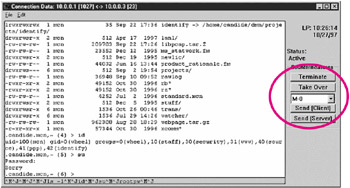
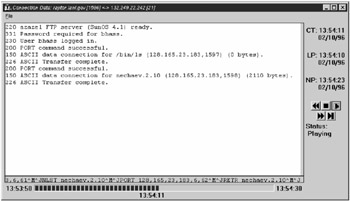
| |
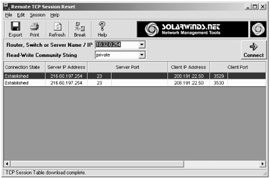
| |
This security tool can remotely display all active sessions on a terminal server, router, dial-in server, access server, etc. The user can reset any TCP session remotely.
Resetting a connection is simple.
-
Start up the remote TCP session reset
-
Enter the IP address of the machine whose connection is to be reset.
-
Enter the read-write community string.
-
Click on connect to retrieve a list of active TCP connections
-
Click on the connection that is to be disconnected, and select 'Break' from the toolbar.
| |
-
Use Encryption
-
Use a secure protocol
-
Limit incoming connections
-
Minimize remote access
-
Have strong authentication.
| |
| Countermeasure | When practical, limit successful sessions to specific IP addresses. This usually only works when dealing within an intranet setting, where the IP ranges are predictable and finite. |
| Countermeasure | Re-authenticate the user before critical actions are performed. If possible, try to limit unique session tokens to each browser instance (e.g. generate the token with a hash of the MAC address of the computer and process id of the browser, etc.) Configure the appropriate spoof rules on gateways (internal and external). Monitor for ARP cache poisoning, by using IDS products or ARPwatch. |
| Countermeasure | Use x.509 certificates to prevent more traditional types of TCP hijacking. |
| Countermeasure | Use encryption. This can be done by one or more of the following.
|
| Countermeasure | Use strong authentication (like Kerberos) or peer-to-peer VPN's. |
| |
-
In the case of a session hijacking an attacker relies on the legitimate user to connect and authenticate and then take over the session.
-
In spoofing attack, the attacker pretends to be another user or machine to gain access.
-
Successful session hijacking is extremely difficult and only possible when a number of factors are under the attacker s control.
-
Session hijacking can be active or passive in nature depending on the degree of involvement of the attacker in the attack.
-
A variety of tools exist to aid the attacker in perpetrating a session hijack.
-
Session Hijacking could be very dangerous and there is a need for implementing strict countermeasures.
| |
EAN: N/A
Pages: 109
- Security Architecture and Design
- Legal, Regulations, Compliance, and Investigations
- Initiation of the System Authorization Process
- Appendix C The Information System Security Architecture Professional (ISSAP) Certification
- Appendix E The Information System Security Management Professional (ISSMP) Certification